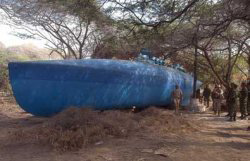
|
 |
 |
 Americas & Beyond | May 2008 Americas & Beyond | May 2008  
Drugs by Submarine, from Colombia via Mexico to the USA
 Barnard R. Thompson - Mexidata.info Barnard R. Thompson - Mexidata.info
go to original


| | Largest of the semi-submarines seized by Colombia - 2007. (Colombia Air Force) | | |
On Sunday, April 27, the Mexico City newspaper El Universal ran three articles about so-called “semi-submarines,” near wholly submersibles that are being used more and more to covertly transport narcotics from Colombia to the United States – in most cases via Mexico. Quoting U.S. Coast Guard (USCG), law enforcement, naval and other sources, the news reports were quite similar to a CNN.com piece that ran a month earlier, Coast Guard hunts drug-running semi-subs, which included a USCG video hunting drug trafficking subs.

Still, apart from possible questions about initial sources this news needs to be disseminated.

The front-page El Universal summary begins, “Reports from the United States and Colombia indicate that narcotrafficking has changed from speedboats to new generation submarines, which has allowed the avoidance of radar in transporting large volumes of pure cocaine to the United States.” Some yet not all of the vessels, that can carry as much as 12 tons, are operated by remote control it added.

Quoting unnamed USCG sources, the news stories said that more than ten of the submarines have been captured over the past 12 months, topping the total for the entire preceding decade. One article went on to say that, according to USCG projections, 85 of the submarines might be detained in 2008, a figure that could reach 120 in 2009.

Reportedly the Colombian Navy has seized another 13 of the semi-submersibles over the last year.

According to the reports, the Russian designed steel-hulled vessels cost on the average US$1 million to build. They are being manufactured in Colombia, where the Norte del Valle drug cartel is in league with terrorism-inclined guerrillas of the Revolutionary Armed Forces of Colombia, or FARC, who guard the secret shipbuilding operations.

To maintain secrecy, some ten to 15 workers are kept in seclusion for up to five months until each submersible is completed. And while sailing northbound at about 12 knots along Central America’s east coast to Mexico’s Yucatan peninsula, and then on to the United States, is supposedly the route of choice, the preferential area to build and launch the vessels is said to be on Colombia’s Pacific coast, where jungle foliage helps to hide construction and cargo loading sites.

As to the semi-submarines, size and hold capacity can be estimated using one – which may be atypical as it is supposedly the largest discovered to date – that was being loaded and nearly ready to sail the Caribbean route when seized by the Colombian military last summer. The newspaper (using information from an article originally published in Colombia’s El Tiempo) said it was 16.8 meters long [52.5 feet], 3.5 meters wide [11.5 feet], and weighed 46.6 tons. When captured some 10 tons of cocaine were in its hold.

At sea, with just the tops of the vessels visible above surface level (including escape hatches or tubes on the manned versions), “They are very small to be detected by radar or from an aircraft,” according to Colombian Admiral Gabriel García. Furthermore, they do not leave a wake.

As well, if and when intercepted by coast guards or naval vessels the unmarked subs can be abandoned and sunk, sending the contraband and other evidence to the ocean floor and thus mitigating many causes for arrest and prosecution.

The most popular course for the Colombian submarines, en route to the United States, is to the Caribbean coast of Mexico’s Yucatan peninsula El Universal says. Once in Mexico the shipments come under the protection of Mexico’s drug cartels, especially “The Federation” that controls the northbound drug trafficking corridors from Yucatan, data which the newspaper says comes from reports of the U.S. Drug Enforcement Administration (DEA).

The DEA’s “National Drug Threat Assessment 2008” says, “The Alliance, also known as The Federation, is a cooperating group of Mexican drug trafficking organizations that share resources such as transportation routes and money launderers. The Alliance was formed to counter the Gulf Cartel. The Alliance includes organizations headed by Joaquín Guzmán-Loera, Ismael Zambada-García, Juan José Esparragosa-Moreno, Arturo and Hector Beltrán-Leyva, Edgar Valdez-Villareal, Armando Valencia-Cornelio, and Ignazio Coronel-Villareal.”

El Universal continues: “When vigilance is increased in an area, the protection of the Mexican cartels has allowed the submarines to simply change the route from Colombia in order not to travel via the Caribbean, (traveling instead) by way of the Pacific where The Federation also dominates, USCG and DEA information indicates.”

Also see U.S. Navy Re-Establishes Fourth Fleet in Central & South America, Caribbean, USDOD - 28 April 2008, MexiData.info; and The 16 Ton Catch, Military.com, April 8, 2008.

Barnard Thompson, editor of MexiData.info, has spent 50 years in Mexico and Latin America, providing multinational clients with actionable intelligence; country and political risk reporting and analysis; and business, lobbying, and problem resolution services. | 
 | |
 |



